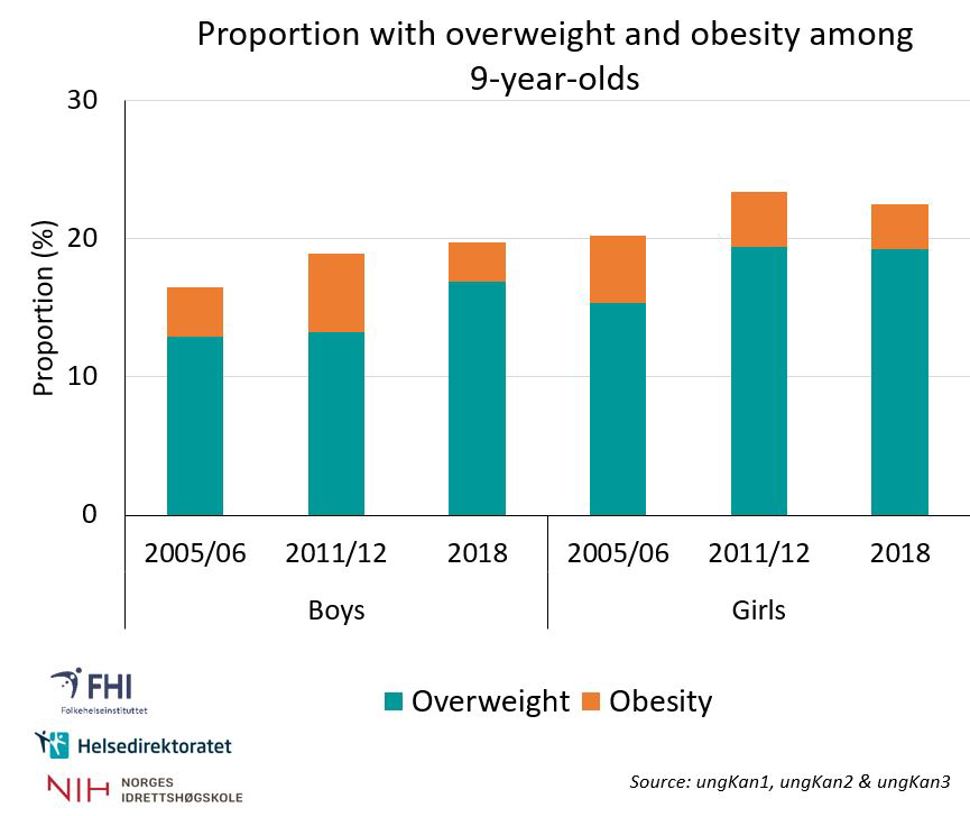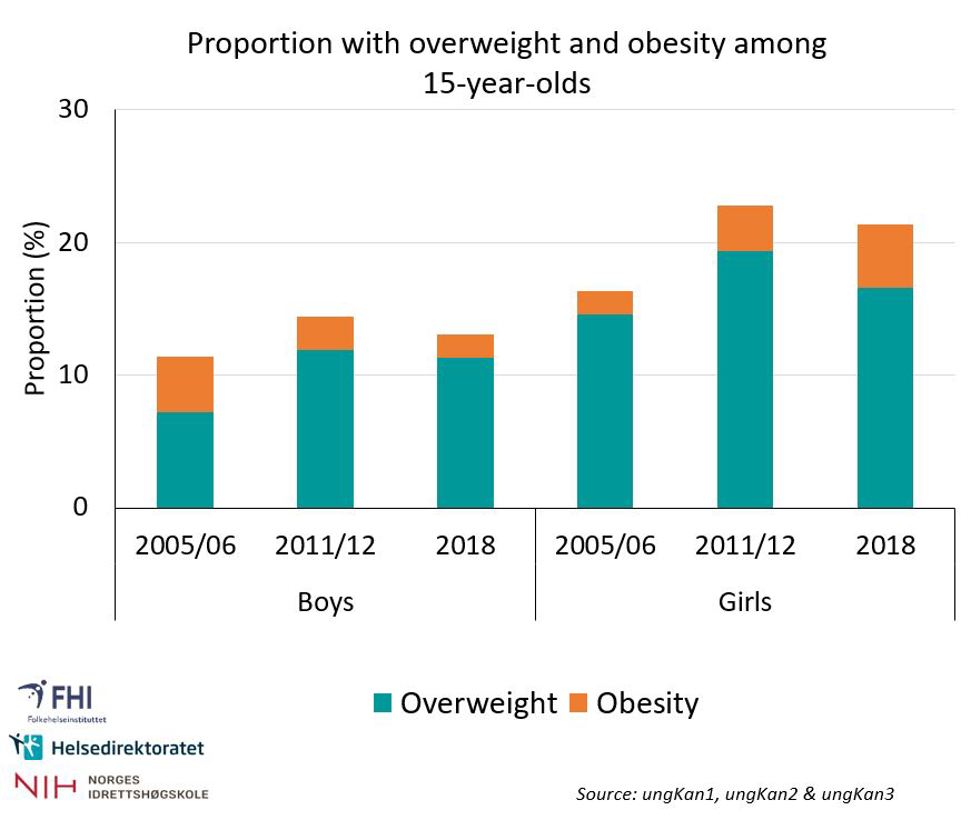Overweight and obesity in adolescents (Indicator 13)
Updated
The indicator describes the following: Prevalence of overweight and obesity in adolescents.
This indicator is part of Target (7): Halt the rise in diabetes and obesity.
The indicator is based on measured height and weight among a representative sample of children and adolescents taken from the general population.
Results
During the period 2005-2019, the proportion of 8 and 9-year-olds with overweight and obesity has remained relatively stable, at just under 20 % for boys and about 20 % among girls. The proportion of individuals with obesity has also remained stable between 2 and 6 %. This is shown by figures from the Child Growth Study (Figure 1) and from the Physical Activity among Norwegian Children Studies, PANCS1, PANCS2 and PANCS3 (Figure 2).
During the period 2005/2006 to 2011/2012, the proportion of 15-year-olds with overweight and obesity increased, while it was relatively stable between 2011/2012 and 2018. Among 15-year-old boys, the proportion with overweight remained relatively stable between 2005/2006 and 2018, and the proportion of 15-year-old boys with obesity declined from 4 % in 2005 to 2 % in 2018. This means that the increase in proportion of 15-year-olds with overweight or obesity is mainly driven by changes among girls. In 2005/06, the proportion of 15-year-old girls with overweight or obesity was approximately 16 %, whereas in 2018 it was approximately 21 %. Over the same period, the proportion of 15-year-old girls with obesity has more than doubled, from about 2 % in 2005/2006 to about 5 % in 2018.
This is shown by figures from the Physical Activity among Norwegian Children Studies, PANCS1, PANCS2 and PANCS3 (Figure 3).
![Figure 1: Percentage of 8-year-old boys and girls with overweight and obesity in the period 2008–2019. Source: The Child Growth Study, Norgeshelsa statistikkbank [Norway Health Statistics Database] Norwegian Institute of Public Health. See table below. Figure 1: Percentage of 8-year-old boys and girls with overweight and obesity in the period 2008–2019](/contentassets/c7a9e00761b54b538a398b936a9829e0/2023-en-fedme-ungdom-8-aring.png?preset=mainbodywidth&maxwidth=970&width=970)
2008 | 2010 | 2012 | 2015 | 2019 | |
Boys |
|
|
|
|
|
Overweight | 11 | 12 | 11 | 11 | 11 |
Obesity | 3 | 4 | 3 | 2 | 3 |
Overweight and obesity | 14 | 16 | 14 | 14 | 15 |
Girls |
|
|
|
|
|
Overweight | 13 | 17 | 13 | 14 | 15 |
Obesity | 4 | 3 | 4 | 3 | 4 |
Overweight and obesity | 16 | 20 | 18 | 17 | 19 |
Total |
|
|
|
|
|
Overweight | 12 | 14 | 12 | 13 | 13 |
Obesity | 3 | 4 | 4 | 3 | 4 |
Overweight and obesity | 15 | 18 | 16 | 15 | 17 |

2005/2006 | 2011 | 2018 | |
Boys |
|
|
|
Overweight | 13 | 13 | 17 |
Obesity | 4 | 6 | 3 |
Overweight and obesity | 16 | 19 | 20 |
Girls |
|
|
|
Overweight | 15 | 19 | 19 |
Obesity | 5 | 4 | 3 |
Overweight and obesity | 20 | 23 | 23 |
Total |
|
|
|
Overweight | 14 | 16 | 18 |
Obesity | 4 | 5 | 3 |
Overweight and obesity | 18 | 21 | 21 |

2005/2006 | 2011/2012 | 2018 | |
Boys |
|
|
|
Overweight | 7 | 12 | 11 |
Obesity | 4 | 3 | 2 |
Overweight and obesity | 11 | 14 | 13 |
Girls |
|
|
|
Overweight | 15 | 19 | 17 |
Obesity | 2 | 3 | 5 |
Overweight and obesity | 16 | 23 | 21 |
Total |
|
|
|
Overweight | 11 | 15 | 14 |
Obesity | 3 | 3 | 3 |
Overweight and obesity | 14 | 18 | 17 |
Data sources
The data source for this indicator is Child Growth Study (8-year-olds) and the Physical Activity among Norwegian Children Study among 9- and 15-year-olds (PANCS).
A description and definitions follow below.
Data source: Child Growth Study
Description
The Child Growth Study measures height, weight and waist circumference in a nationally representative sample of 3rd grade pupils (8-year-olds) in primary school. The study was conducted in 2008, 2010, 2012, 2015 and 2019 in collaboration with the School Health Service. The Child Growth Study is partly financed by the Ministry of Health and Care Services and is administered by the Norwegian Institute of Public Health.
Effect measure
- Proportion of 8-year-olds with overweight (not obesity), as a percentage.
- Proportion of 8-year-olds with obesity, as a percentage.
- Proportion of 8-year-olds with overweight and obesity, as a percentage.
The data are based on physical measurements, and the threshold values of the International Obesity Task Force (IOTF) are used to classify overweight and obesity, also known as the Cole Index (Cole TJ, BMJ 2000), Cole TH & Lobstein T, Ped Obes 2012).
IOTF’s threshold values classify overweight and obesity based on body mass index (BMI). BMI thresholds for overweight and obesity are not the same for children as for adults. Children are differently proportioned, so threshold values must be based on the actual build of children at a given age. IOTF’s threshold values for children and adolescents are provided for boys and girls at half-year cut-off points between two and 18 years of age. The values are established by an international expert group and are based on six major international cross-sectional studies from Brazil, the UK, Hong Kong, the Netherlands, Singapore and the US (Cole TJ, BMJ 2000), Cole TJ & Lobstein T, Ped Obes 2012).
Data quality
Statistics Norway (SSB) selected schools in such a way as to render the sample representative on both a national and a health region level. The participation rate among pupils was high in all the rounds of the survey.
The pupils were individually weighed and measured, wearing light clothing, at the School Health Service office. The tables of results are adjusted for clothing.
Interpretation and sources of error
The Child Growth Study is part of the monitoring programme the WHO European Childhood Obesity Surveillance Initiative (COSI), which enables comparisons of results among several European countries.
References:
- Cole TJ, Bellizzi MC, Flegal KM et al. Establishing a standard definition for child overweight and obesity worldwide: international survey. BMJ. 2000;320(7244):1240-1243.
- Cole, T.J. and Lobstein, T. (2012), Extended international BMI cut-offs. Pediatric Obesity, 7: 284-294.
Data source: Physical Activity among Norwegian Children Study - PANCS
Description
Physical activity and physical fitness among 9 and 15-year-olds in Norway (PANCS) was examined in nationally representative samples in 2005-2006, 2011-2012 and 2018. The examinations also included height, weight and waist circumference measurements. PANCS 1–3 was conducted by the Norwegian School of Sport Sciences in collaboration with the Norwegian Directorate of Health and the Norwegian Institute of Public Health. PANCS4 is being conducted by the Norwegian School of Sport Sciences in collaboration with the Norwegian Directorate of Health and the Norwegian Institute of Public Health during 2024–2026.
Effect measure
- Proportion of 9-year-olds with overweight (not obesity), as a percentage.
- Proportion of 9-year-olds with obesity, as a percentage.
- Proportion of 9-year-olds with overweight and obesity, as a percentage.
- Proportion of 15-year-olds with overweight (not obesity), as a percentage.
- Proportion of 15-year-olds with obesity, as a percentage.
- Proportion of 15-year-olds with overweight and obesity, as a percentage.
The data are based on physical measurements, and the threshold values of the International Obesity Task Force (IOTF) are used to classify overweight and obesity, also known as the Cole Index. For details and references see Effect measure under Data source: Child Growth Study above.
When comparing anthropometric data between the PANCS samples, it is important to take into account that the average age within the age groups varies somewhat from time to time (the 15-year-olds in the PANCS1 study, for example, were about 0.4 years older on average than 15-year-olds in the PANCS2 study). This is taken into account in the calculation of the target figures. It is therefore noted that the target figures may differ somewhat from the cross-sectional data given in the reports from the individual PANCS studies.
Data quality
Schools across the entire country are selected for the PANCS studies and invited to participate. Selection takes into consideration geography and population density, which ensured that the invited 9- and 15-year-olds constitutes a representative sample of Norwegian 9- and 15-year-olds.
The proportion of those invited who agreed to participate has been high in all studies but has declined somewhat over time. In 2005/2006, 89 % of 9-year-olds said yes to participation. In 2011/2012 and 2018, the corresponding participation was 73 % and 73 %. In 2005/2006, 74 % of 15-year-olds agreed to participate. In 2011/2012 and 2018, the corresponding participation was 63 % and 58 %.
Interpretation and sources of error
The estimated prevalence of overweight and obesity is influenced by the sample being studied. For children and adolescents, the prevalence data may also vary depending on the threshold values used to classify overweight and obesity. In the PANCS studies, the threshold values of the Cole Index were chosen (see above) since these are standardized in respect of age and gender and directly comparable to the threshold values for overweight (BMI 25-29,9) and obesity (BMI ≥ 30) in adults. Where other threshold values are used, e.g. those of de Onis et al (de Onis et al., 2007), the prevalence data will change.
In the PANCS studies, the measurement of height and weight followed the same clinical standards on both measurement dates. The BMI values from 2005/2006, 2011/2012 and 2018 are therefore valid, and future measurements will be easily reproducible.
References
National adaptation to global indicators
WHO’s definition of the indicator
Indicator 13. Prevalence of overweight and obesity in adolescents (defined according to the WHO growth reference for school-aged children and adolescents, overweight – one standard deviation body mass index for age and sex, and obese – two standard deviations body mass index for age and sex).
National adaptation
Age and gender-specific BMI threshold values were used. These threshold values are based on six studies which taken together include more than 190 000 children and adolescents, where the standardised threshold values for overweight and obesity are equivalent to adult BMI values of 25-29,9 (overweight) and ≥ 30 (obesity). WHO’s definition was not used (de Onis Bull World Health Organ. 2007).

